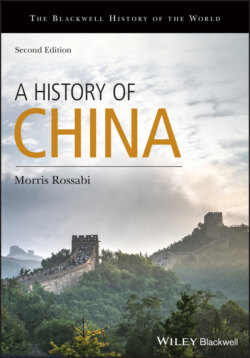Читать книгу A History of China - Morris Rossabi - Страница 10
ОглавлениеACKNOWLEDGMENTS
This book has evolved from courses I have taught since 1965 on Chinese history. Through their positive and negative reactions, my students have led me to incorporate changes in this survey course – additions and deletions that have, I believe, benefited this volume. I am grateful to these students for their questions and insights because they have had a substantial influence on my thinking. They are now occupational therapists, teachers, lawyers, policemen, doctors, soldiers, and workers, among other occupations, and are perhaps far removed from the study of Chinese history, but their contributions to this work ought to be mentioned. Similarly, I want to acknowledge the numerous secondary-school teachers and instructors in colleges who took part in outreach programs designed to assist them in introducing units on Chinese history in their curricula. In my presentations to them, I had to compress a whole semester’s worth of lectures into a week or two of intensive talks. Such condensation prompted me to focus on what I perceived to be the most important developments and themes in the history of China, and this process was an invaluable contribution to this book.
I learned a great deal in discussions with the late Hans Bielenstein, the late L. C. Goodrich, and the late Morton Fried, all of Columbia University; Roderick Ptak and the late Herbert Franke of the University of Munich; the late John Langlois of Bowdoin College; John Meskill of Barnard College; the late Hok-lam Chan of the University of Washington; the late Frederick Wakeman of the University of California at Berkeley; the late Michael Gasster of Rutgers University; the late Frederick Mote of Princeton University; the late Joseph Fletcher of Harvard University; John Wills and Bettine Birge of the University of Southern California; David Robinson of Colgate University; Edward Farmer of the University of Minnesota; Ralph Kauz and Veronika Veit of Bonn University; Liu Yingsheng of Nanjing University; Leonard Blusse of Leiden University; Angela Schottenhammer of Salzburg University; Joanna Waley-Cohen of New York University; Pamela Crossley of Dartmouth College; Nancy S. Steinhardt of the University of Pennsylvania; John Chaffee of the University of Binghamton; Caroline Humphrey of Cambridge University; and the late Father Henry Serruys, Dr. Paula Harrell, Dr. Stan Czuma, and the late Dr. Sherman Lee of the Cleveland Museum of Art. Professor Robert Moore, the editor of this series of volumes on world history, has offered invaluable suggestions for revisions, and Tessa Harvey of Wiley Blackwell has been extremely patient and supportive. Two anonymous reviewers provided extraordinarily helpful comments. I am certain that I have omitted the names of other colleagues and friends who have influenced my conception of Chinese history and hope that they will forgive me for my failing memory.
My own family has been extremely supportive over the years. My older brother Mayer, whose life was cut short by a virulent form of brain cancer in 1998, taught me so much – from a concern for social justice to skills such as swimming – that it is difficult to imagine what I would have become without his influence. I think of him daily and hope he realized how important he was in my life and career. Like their father Mayer, Joseph and Amiel Rossabi are decent and honorable, and they have been helpful to me and my immediate family over the years. My daughter Amy and my son Tony and their respective families – Howard, Sarah, and Nathan Sterinbach and Anna and Julia Rossabi – have been a source of joy, stimulation, and assistance throughout the writing of this book, although Julia, then two years old, is probably not aware of her contribution.
My wife Mary is always mentioned last but should be first, and I don’t say so merely because she will be the first person to read these acknowledgments. Indeed, she has read every book and article (even my doctoral dissertation!) that I’ve ever written and has improved all of them through her suggestions for change. We have also collaborated on five books over the years, pleasurable experiences for both of us. Her intelligence, energy, and sense of humor have enriched both of our lives.
ACKNOWLEDGEMENTS FOR SECOND EDITION
I have taken advantage of the opportunity offered by a second edition to correct some errors in style and substance, to add a few comments based on the latest research, and to bring the history up to date, as of 2020.
In the decade since I completed the original edition, a number of close friends and colleagues have died. I miss their wise counsel which was always leavened with humor. I dedicate this work to them.
